PROJ6006 - Project Team Management Report: Leadership Strategies
VerifiedAdded on 2022/09/14
|8
|2334
|20
Report
AI Summary
This report provides a comprehensive analysis of project team management, focusing on leadership styles, influence techniques, and team development strategies. It explores the adoption of a participative leadership style, emphasizing the importance of involving team members in decision-makin...

Running Head: PROJECT TEAM 0
Management
Management
Paraphrase This Document
Need a fresh take? Get an instant paraphrase of this document with our AI Paraphraser
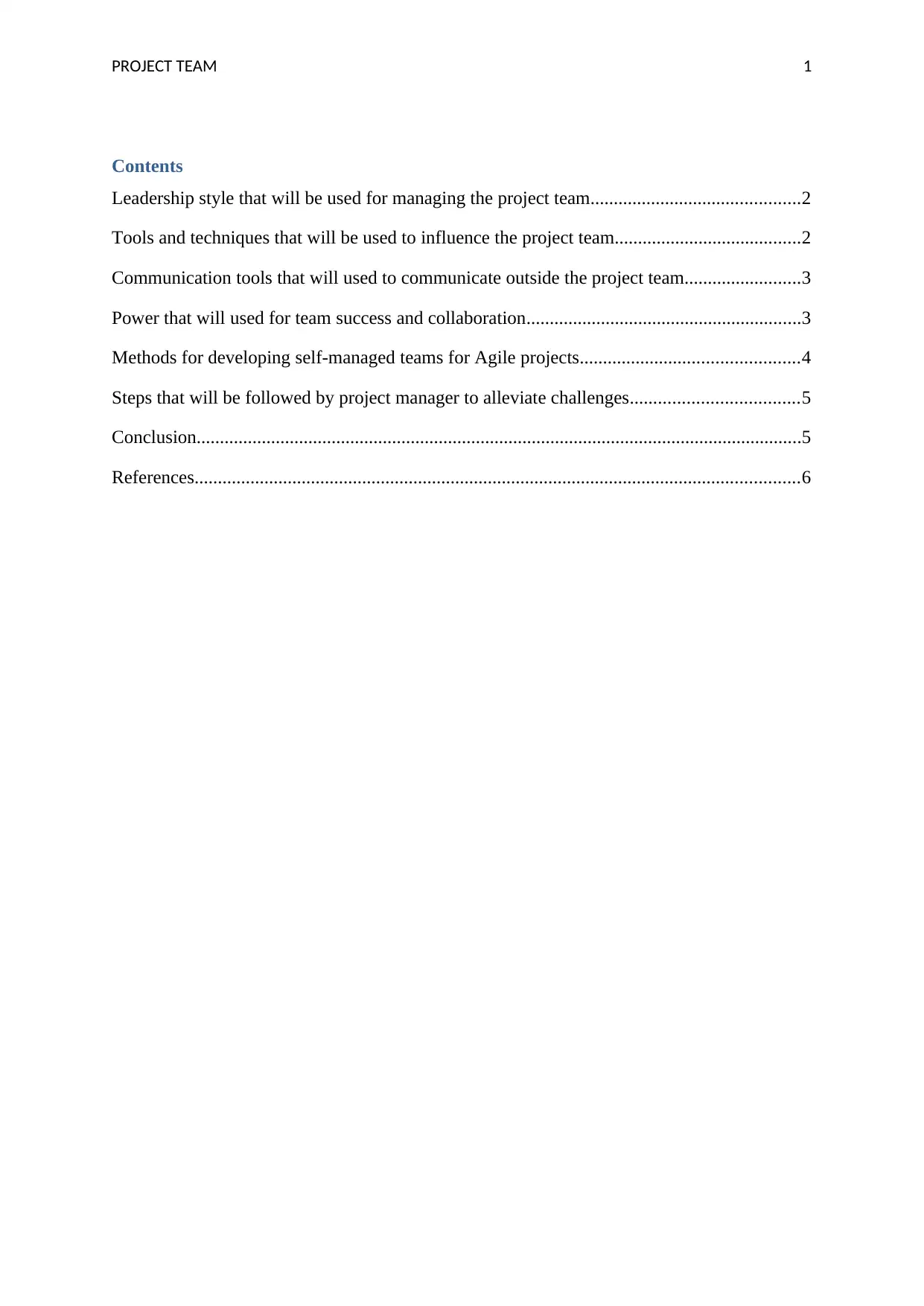
PROJECT TEAM 1
Contents
Leadership style that will be used for managing the project team.............................................2
Tools and techniques that will be used to influence the project team........................................2
Communication tools that will used to communicate outside the project team.........................3
Power that will used for team success and collaboration...........................................................3
Methods for developing self-managed teams for Agile projects...............................................4
Steps that will be followed by project manager to alleviate challenges....................................5
Conclusion..................................................................................................................................5
References..................................................................................................................................6
Contents
Leadership style that will be used for managing the project team.............................................2
Tools and techniques that will be used to influence the project team........................................2
Communication tools that will used to communicate outside the project team.........................3
Power that will used for team success and collaboration...........................................................3
Methods for developing self-managed teams for Agile projects...............................................4
Steps that will be followed by project manager to alleviate challenges....................................5
Conclusion..................................................................................................................................5
References..................................................................................................................................6
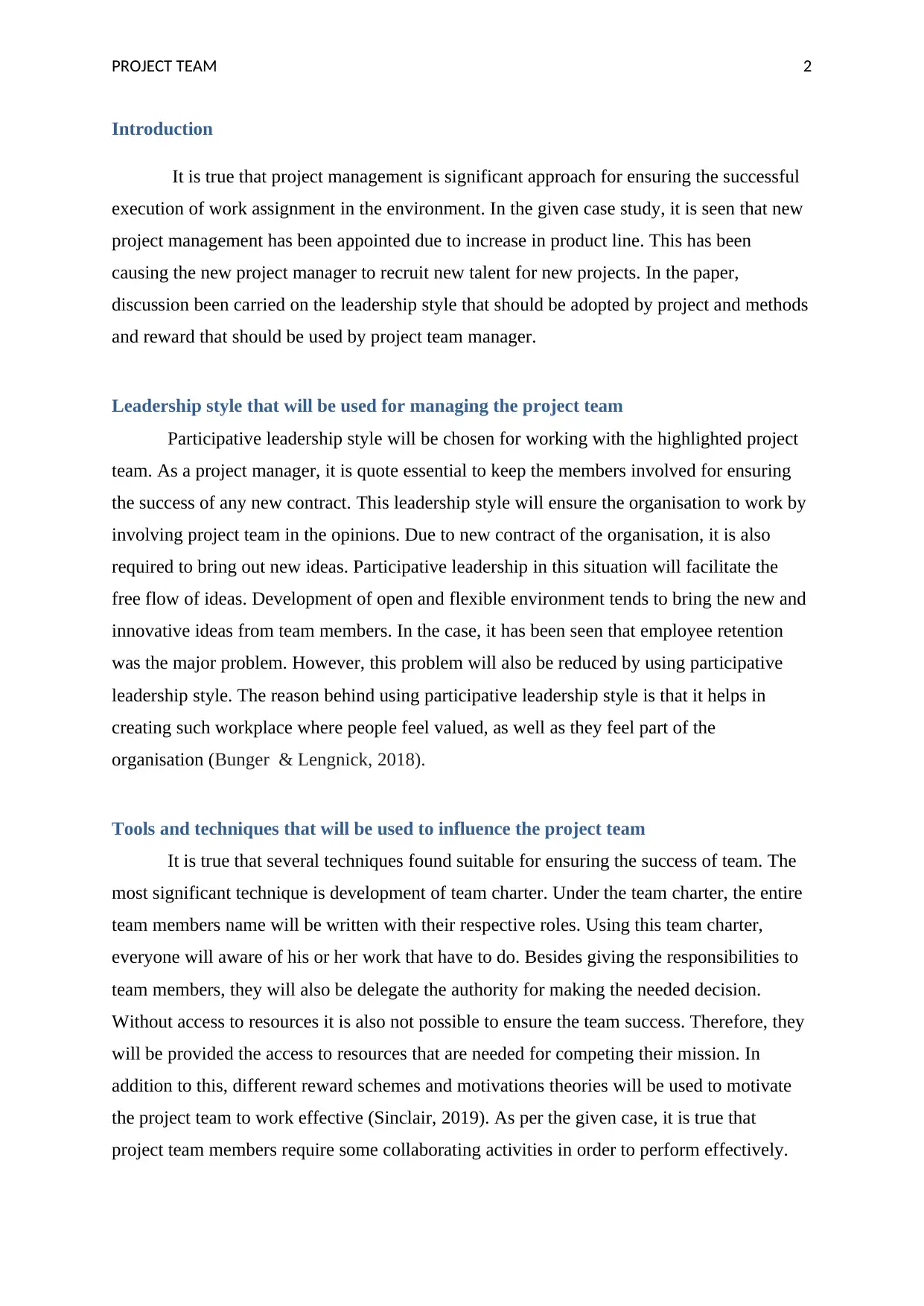
PROJECT TEAM 2
Introduction
It is true that project management is significant approach for ensuring the successful
execution of work assignment in the environment. In the given case study, it is seen that new
project management has been appointed due to increase in product line. This has been
causing the new project manager to recruit new talent for new projects. In the paper,
discussion been carried on the leadership style that should be adopted by project and methods
and reward that should be used by project team manager.
Leadership style that will be used for managing the project team
Participative leadership style will be chosen for working with the highlighted project
team. As a project manager, it is quote essential to keep the members involved for ensuring
the success of any new contract. This leadership style will ensure the organisation to work by
involving project team in the opinions. Due to new contract of the organisation, it is also
required to bring out new ideas. Participative leadership in this situation will facilitate the
free flow of ideas. Development of open and flexible environment tends to bring the new and
innovative ideas from team members. In the case, it has been seen that employee retention
was the major problem. However, this problem will also be reduced by using participative
leadership style. The reason behind using participative leadership style is that it helps in
creating such workplace where people feel valued, as well as they feel part of the
organisation (Bunger & Lengnick, 2018).
Tools and techniques that will be used to influence the project team
It is true that several techniques found suitable for ensuring the success of team. The
most significant technique is development of team charter. Under the team charter, the entire
team members name will be written with their respective roles. Using this team charter,
everyone will aware of his or her work that have to do. Besides giving the responsibilities to
team members, they will also be delegate the authority for making the needed decision.
Without access to resources it is also not possible to ensure the team success. Therefore, they
will be provided the access to resources that are needed for competing their mission. In
addition to this, different reward schemes and motivations theories will be used to motivate
the project team to work effective (Sinclair, 2019). As per the given case, it is true that
project team members require some collaborating activities in order to perform effectively.
Introduction
It is true that project management is significant approach for ensuring the successful
execution of work assignment in the environment. In the given case study, it is seen that new
project management has been appointed due to increase in product line. This has been
causing the new project manager to recruit new talent for new projects. In the paper,
discussion been carried on the leadership style that should be adopted by project and methods
and reward that should be used by project team manager.
Leadership style that will be used for managing the project team
Participative leadership style will be chosen for working with the highlighted project
team. As a project manager, it is quote essential to keep the members involved for ensuring
the success of any new contract. This leadership style will ensure the organisation to work by
involving project team in the opinions. Due to new contract of the organisation, it is also
required to bring out new ideas. Participative leadership in this situation will facilitate the
free flow of ideas. Development of open and flexible environment tends to bring the new and
innovative ideas from team members. In the case, it has been seen that employee retention
was the major problem. However, this problem will also be reduced by using participative
leadership style. The reason behind using participative leadership style is that it helps in
creating such workplace where people feel valued, as well as they feel part of the
organisation (Bunger & Lengnick, 2018).
Tools and techniques that will be used to influence the project team
It is true that several techniques found suitable for ensuring the success of team. The
most significant technique is development of team charter. Under the team charter, the entire
team members name will be written with their respective roles. Using this team charter,
everyone will aware of his or her work that have to do. Besides giving the responsibilities to
team members, they will also be delegate the authority for making the needed decision.
Without access to resources it is also not possible to ensure the team success. Therefore, they
will be provided the access to resources that are needed for competing their mission. In
addition to this, different reward schemes and motivations theories will be used to motivate
the project team to work effective (Sinclair, 2019). As per the given case, it is true that
project team members require some collaborating activities in order to perform effectively.
⊘ This is a preview!⊘
Do you want full access?
Subscribe today to unlock all pages.

Trusted by 1+ million students worldwide
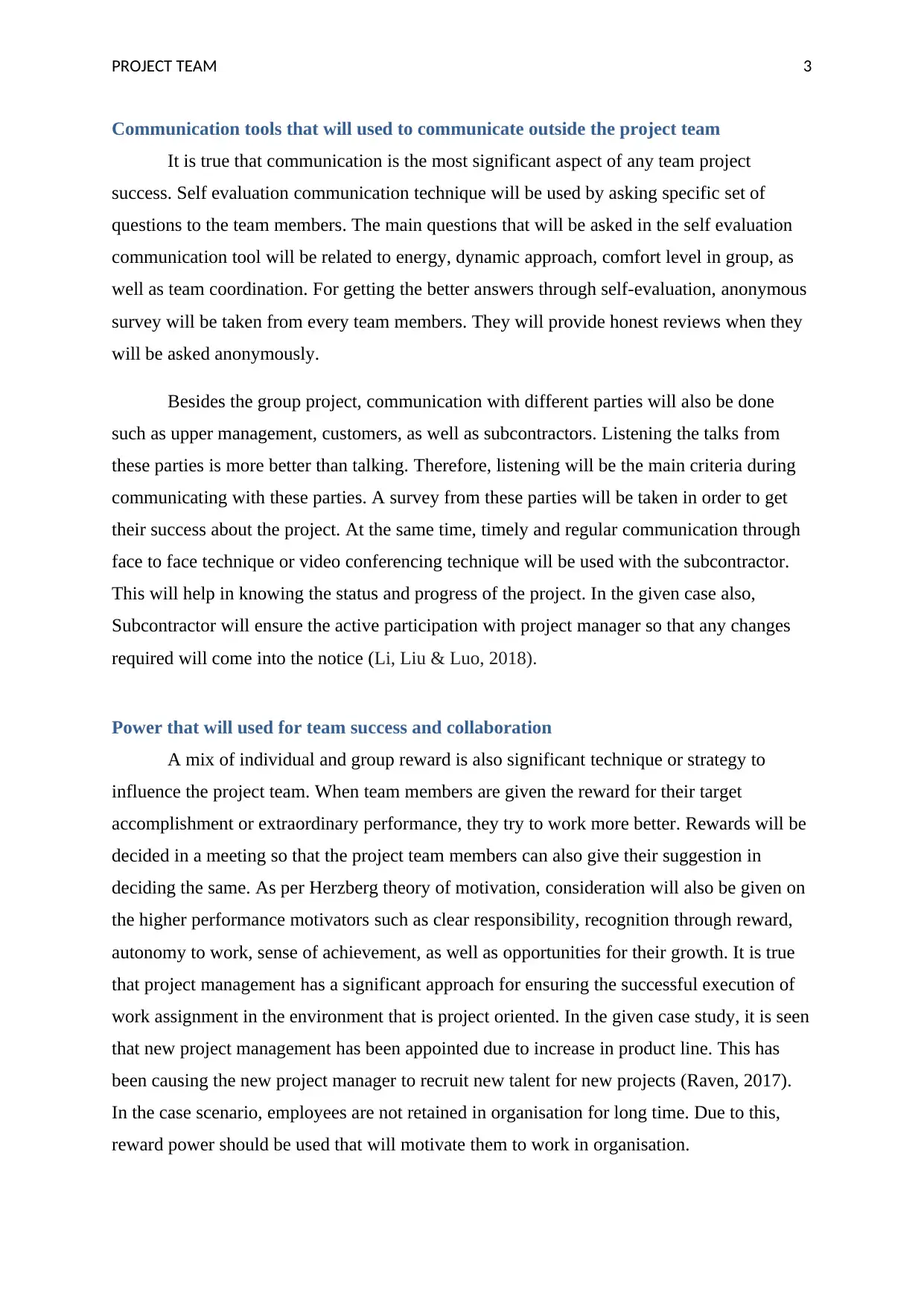
PROJECT TEAM 3
Communication tools that will used to communicate outside the project team
It is true that communication is the most significant aspect of any team project
success. Self evaluation communication technique will be used by asking specific set of
questions to the team members. The main questions that will be asked in the self evaluation
communication tool will be related to energy, dynamic approach, comfort level in group, as
well as team coordination. For getting the better answers through self-evaluation, anonymous
survey will be taken from every team members. They will provide honest reviews when they
will be asked anonymously.
Besides the group project, communication with different parties will also be done
such as upper management, customers, as well as subcontractors. Listening the talks from
these parties is more better than talking. Therefore, listening will be the main criteria during
communicating with these parties. A survey from these parties will be taken in order to get
their success about the project. At the same time, timely and regular communication through
face to face technique or video conferencing technique will be used with the subcontractor.
This will help in knowing the status and progress of the project. In the given case also,
Subcontractor will ensure the active participation with project manager so that any changes
required will come into the notice (Li, Liu & Luo, 2018).
Power that will used for team success and collaboration
A mix of individual and group reward is also significant technique or strategy to
influence the project team. When team members are given the reward for their target
accomplishment or extraordinary performance, they try to work more better. Rewards will be
decided in a meeting so that the project team members can also give their suggestion in
deciding the same. As per Herzberg theory of motivation, consideration will also be given on
the higher performance motivators such as clear responsibility, recognition through reward,
autonomy to work, sense of achievement, as well as opportunities for their growth. It is true
that project management has a significant approach for ensuring the successful execution of
work assignment in the environment that is project oriented. In the given case study, it is seen
that new project management has been appointed due to increase in product line. This has
been causing the new project manager to recruit new talent for new projects (Raven, 2017).
In the case scenario, employees are not retained in organisation for long time. Due to this,
reward power should be used that will motivate them to work in organisation.
Communication tools that will used to communicate outside the project team
It is true that communication is the most significant aspect of any team project
success. Self evaluation communication technique will be used by asking specific set of
questions to the team members. The main questions that will be asked in the self evaluation
communication tool will be related to energy, dynamic approach, comfort level in group, as
well as team coordination. For getting the better answers through self-evaluation, anonymous
survey will be taken from every team members. They will provide honest reviews when they
will be asked anonymously.
Besides the group project, communication with different parties will also be done
such as upper management, customers, as well as subcontractors. Listening the talks from
these parties is more better than talking. Therefore, listening will be the main criteria during
communicating with these parties. A survey from these parties will be taken in order to get
their success about the project. At the same time, timely and regular communication through
face to face technique or video conferencing technique will be used with the subcontractor.
This will help in knowing the status and progress of the project. In the given case also,
Subcontractor will ensure the active participation with project manager so that any changes
required will come into the notice (Li, Liu & Luo, 2018).
Power that will used for team success and collaboration
A mix of individual and group reward is also significant technique or strategy to
influence the project team. When team members are given the reward for their target
accomplishment or extraordinary performance, they try to work more better. Rewards will be
decided in a meeting so that the project team members can also give their suggestion in
deciding the same. As per Herzberg theory of motivation, consideration will also be given on
the higher performance motivators such as clear responsibility, recognition through reward,
autonomy to work, sense of achievement, as well as opportunities for their growth. It is true
that project management has a significant approach for ensuring the successful execution of
work assignment in the environment that is project oriented. In the given case study, it is seen
that new project management has been appointed due to increase in product line. This has
been causing the new project manager to recruit new talent for new projects (Raven, 2017).
In the case scenario, employees are not retained in organisation for long time. Due to this,
reward power should be used that will motivate them to work in organisation.
Paraphrase This Document
Need a fresh take? Get an instant paraphrase of this document with our AI Paraphraser
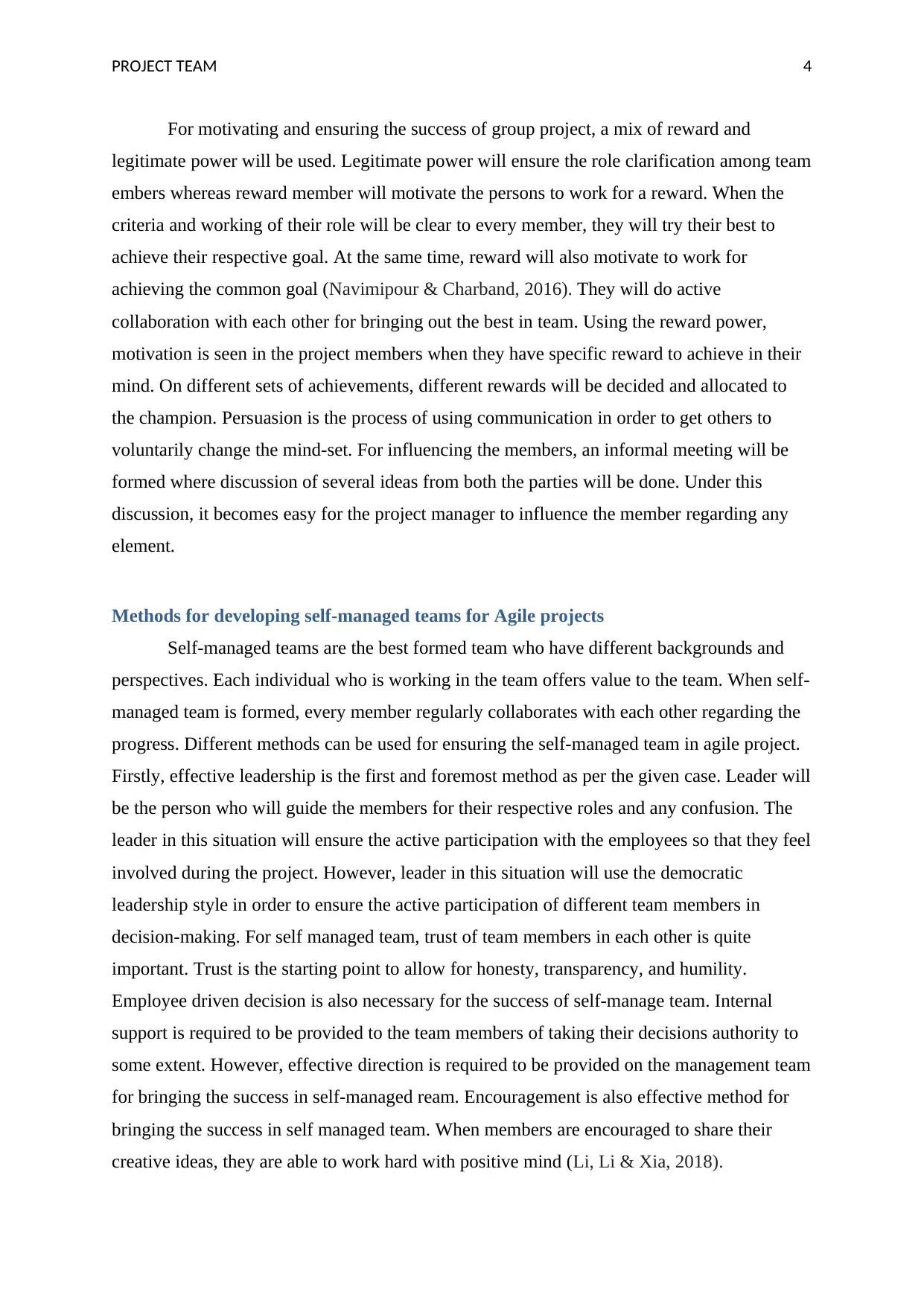
PROJECT TEAM 4
For motivating and ensuring the success of group project, a mix of reward and
legitimate power will be used. Legitimate power will ensure the role clarification among team
embers whereas reward member will motivate the persons to work for a reward. When the
criteria and working of their role will be clear to every member, they will try their best to
achieve their respective goal. At the same time, reward will also motivate to work for
achieving the common goal (Navimipour & Charband, 2016). They will do active
collaboration with each other for bringing out the best in team. Using the reward power,
motivation is seen in the project members when they have specific reward to achieve in their
mind. On different sets of achievements, different rewards will be decided and allocated to
the champion. Persuasion is the process of using communication in order to get others to
voluntarily change the mind-set. For influencing the members, an informal meeting will be
formed where discussion of several ideas from both the parties will be done. Under this
discussion, it becomes easy for the project manager to influence the member regarding any
element.
Methods for developing self-managed teams for Agile projects
Self-managed teams are the best formed team who have different backgrounds and
perspectives. Each individual who is working in the team offers value to the team. When self-
managed team is formed, every member regularly collaborates with each other regarding the
progress. Different methods can be used for ensuring the self-managed team in agile project.
Firstly, effective leadership is the first and foremost method as per the given case. Leader will
be the person who will guide the members for their respective roles and any confusion. The
leader in this situation will ensure the active participation with the employees so that they feel
involved during the project. However, leader in this situation will use the democratic
leadership style in order to ensure the active participation of different team members in
decision-making. For self managed team, trust of team members in each other is quite
important. Trust is the starting point to allow for honesty, transparency, and humility.
Employee driven decision is also necessary for the success of self-manage team. Internal
support is required to be provided to the team members of taking their decisions authority to
some extent. However, effective direction is required to be provided on the management team
for bringing the success in self-managed ream. Encouragement is also effective method for
bringing the success in self managed team. When members are encouraged to share their
creative ideas, they are able to work hard with positive mind (Li, Li & Xia, 2018).
For motivating and ensuring the success of group project, a mix of reward and
legitimate power will be used. Legitimate power will ensure the role clarification among team
embers whereas reward member will motivate the persons to work for a reward. When the
criteria and working of their role will be clear to every member, they will try their best to
achieve their respective goal. At the same time, reward will also motivate to work for
achieving the common goal (Navimipour & Charband, 2016). They will do active
collaboration with each other for bringing out the best in team. Using the reward power,
motivation is seen in the project members when they have specific reward to achieve in their
mind. On different sets of achievements, different rewards will be decided and allocated to
the champion. Persuasion is the process of using communication in order to get others to
voluntarily change the mind-set. For influencing the members, an informal meeting will be
formed where discussion of several ideas from both the parties will be done. Under this
discussion, it becomes easy for the project manager to influence the member regarding any
element.
Methods for developing self-managed teams for Agile projects
Self-managed teams are the best formed team who have different backgrounds and
perspectives. Each individual who is working in the team offers value to the team. When self-
managed team is formed, every member regularly collaborates with each other regarding the
progress. Different methods can be used for ensuring the self-managed team in agile project.
Firstly, effective leadership is the first and foremost method as per the given case. Leader will
be the person who will guide the members for their respective roles and any confusion. The
leader in this situation will ensure the active participation with the employees so that they feel
involved during the project. However, leader in this situation will use the democratic
leadership style in order to ensure the active participation of different team members in
decision-making. For self managed team, trust of team members in each other is quite
important. Trust is the starting point to allow for honesty, transparency, and humility.
Employee driven decision is also necessary for the success of self-manage team. Internal
support is required to be provided to the team members of taking their decisions authority to
some extent. However, effective direction is required to be provided on the management team
for bringing the success in self-managed ream. Encouragement is also effective method for
bringing the success in self managed team. When members are encouraged to share their
creative ideas, they are able to work hard with positive mind (Li, Li & Xia, 2018).

PROJECT TEAM 5
Steps that will be followed by project manager to alleviate challenges
1. Formulation of plan and objective: On the team charter, each member will be shared
the vision and mission of the project. afterwards, plans and goals will be made clear to every
team member by assigning their respective responsibilities as per their expertise or suitability.
2. Monitor results: when results are monitored at the end of activity, the chances of
deviation might be increase and it might damage the whole project output. In order to avoid
such issue, results will be monitored at the second stage (Oadardi et al, 2018).
3. Take corrective actions: after monitoring the results of the project team members, if
any deviation is found, corrective action is communicated to the respective team member.
4. Expedite activities: In order to overcome from the deviation, team members will be
given the necessary information or instructions that will relevant for their problem. Field
expediting might also be done if any member has major issue in completing the project. This
will help in monitoring the working of the person.
5. Solve technical problems: It is true that team is given technical resources to complete
the job but failures might occur. In case of any technical problem during the project team, a
technical leader will be appointed will assist the members whenever they will be facing any
technical issue.
6. Serve as peacemaker: on the role of project team manager, it is necessary to solve
every problem with peace. I will also keep the things peaceful during ant conflict or nay
major issue occur. Rather than getting hyper or stress, it is better to solve the problems with
peaceful mind.
7. Make trade-offs among time, cost and project scope: it is right that trade offs helps in
maintaining the feasibility of project. for example: if contractor will give the time of any
contract for 6 months, I will shorten the duration of project by four or five months in order to
ensure the feasibility of the project. At the same time, cost will also be included in the project
in the form of materials and human resource.
Conclusion
In the limelight of above discussion, it can be concluded that project manager should
use participative approach. It is because team members will feel valued in the organisation.
At the same time, a mix of reward and legitimate power is required to be use so that they get
proper direction.
Steps that will be followed by project manager to alleviate challenges
1. Formulation of plan and objective: On the team charter, each member will be shared
the vision and mission of the project. afterwards, plans and goals will be made clear to every
team member by assigning their respective responsibilities as per their expertise or suitability.
2. Monitor results: when results are monitored at the end of activity, the chances of
deviation might be increase and it might damage the whole project output. In order to avoid
such issue, results will be monitored at the second stage (Oadardi et al, 2018).
3. Take corrective actions: after monitoring the results of the project team members, if
any deviation is found, corrective action is communicated to the respective team member.
4. Expedite activities: In order to overcome from the deviation, team members will be
given the necessary information or instructions that will relevant for their problem. Field
expediting might also be done if any member has major issue in completing the project. This
will help in monitoring the working of the person.
5. Solve technical problems: It is true that team is given technical resources to complete
the job but failures might occur. In case of any technical problem during the project team, a
technical leader will be appointed will assist the members whenever they will be facing any
technical issue.
6. Serve as peacemaker: on the role of project team manager, it is necessary to solve
every problem with peace. I will also keep the things peaceful during ant conflict or nay
major issue occur. Rather than getting hyper or stress, it is better to solve the problems with
peaceful mind.
7. Make trade-offs among time, cost and project scope: it is right that trade offs helps in
maintaining the feasibility of project. for example: if contractor will give the time of any
contract for 6 months, I will shorten the duration of project by four or five months in order to
ensure the feasibility of the project. At the same time, cost will also be included in the project
in the form of materials and human resource.
Conclusion
In the limelight of above discussion, it can be concluded that project manager should
use participative approach. It is because team members will feel valued in the organisation.
At the same time, a mix of reward and legitimate power is required to be use so that they get
proper direction.
⊘ This is a preview!⊘
Do you want full access?
Subscribe today to unlock all pages.

Trusted by 1+ million students worldwide

PROJECT TEAM 6
References
Aragonés-Beltrán, P., García-Melón, M., & Montesinos-Valera, J. (2017). How to assess
stakeholders' influence in project management? A proposal based on the Analytic
Network Process. International journal of project management, 35(3), 451-462.
Brewer, E. C., & Holmes, T. L. (2016). Better communication= better teams: A
communication exercise to improve team performance. IEEE Transactions on
Professional Communication, 59(3), 288-298.
Bunger, A. C., & Lengnick-Hall, R. (2018). Do learning collaboratives strengthen
communication? A comparison of organizational team communication networks over
time. Health care management review, 43(1), 50.
Li, G., Liu, H., & Luo, Y. (2018). Directive versus participative leadership: Dispositional
antecedents and team consequences. Journal of Occupational and Organizational
Psychology, 91(3), 645-664.
Li, J., Li, J., & Xia, R. (2018). The researches on construction project manager competency
and its application. In Proceedings of the 21st International Symposium on
Advancement of Construction Management and Real Estate (pp. 1455-1461).
Springer, Singapore.
Navimipour, N. J., & Charband, Y. (2016). Knowledge sharing mechanisms and techniques
in project teams: Literature review, classification, and current trends. Computers in
Human Behavior, 62, 730-742.
Odoardi, C., Battistelli, A., Montani, F., & Peiró, J. M. (2019). Affective Commitment,
Participative Leadership, and Employee Innovation: A Multilevel
Investigation. Journal of Work and Organizational Psychology, 35(2), 103-113.
Raven, B. H. (2017). The comparative analysis of power and power preference. In Social
power and political influence (pp. 172-198). Routledge.
Sinclair, D. (2019). Assembling a collaborative project team: Practical tools including
multidisciplinary schedules of services. Routledge.
References
Aragonés-Beltrán, P., García-Melón, M., & Montesinos-Valera, J. (2017). How to assess
stakeholders' influence in project management? A proposal based on the Analytic
Network Process. International journal of project management, 35(3), 451-462.
Brewer, E. C., & Holmes, T. L. (2016). Better communication= better teams: A
communication exercise to improve team performance. IEEE Transactions on
Professional Communication, 59(3), 288-298.
Bunger, A. C., & Lengnick-Hall, R. (2018). Do learning collaboratives strengthen
communication? A comparison of organizational team communication networks over
time. Health care management review, 43(1), 50.
Li, G., Liu, H., & Luo, Y. (2018). Directive versus participative leadership: Dispositional
antecedents and team consequences. Journal of Occupational and Organizational
Psychology, 91(3), 645-664.
Li, J., Li, J., & Xia, R. (2018). The researches on construction project manager competency
and its application. In Proceedings of the 21st International Symposium on
Advancement of Construction Management and Real Estate (pp. 1455-1461).
Springer, Singapore.
Navimipour, N. J., & Charband, Y. (2016). Knowledge sharing mechanisms and techniques
in project teams: Literature review, classification, and current trends. Computers in
Human Behavior, 62, 730-742.
Odoardi, C., Battistelli, A., Montani, F., & Peiró, J. M. (2019). Affective Commitment,
Participative Leadership, and Employee Innovation: A Multilevel
Investigation. Journal of Work and Organizational Psychology, 35(2), 103-113.
Raven, B. H. (2017). The comparative analysis of power and power preference. In Social
power and political influence (pp. 172-198). Routledge.
Sinclair, D. (2019). Assembling a collaborative project team: Practical tools including
multidisciplinary schedules of services. Routledge.
Paraphrase This Document
Need a fresh take? Get an instant paraphrase of this document with our AI Paraphraser
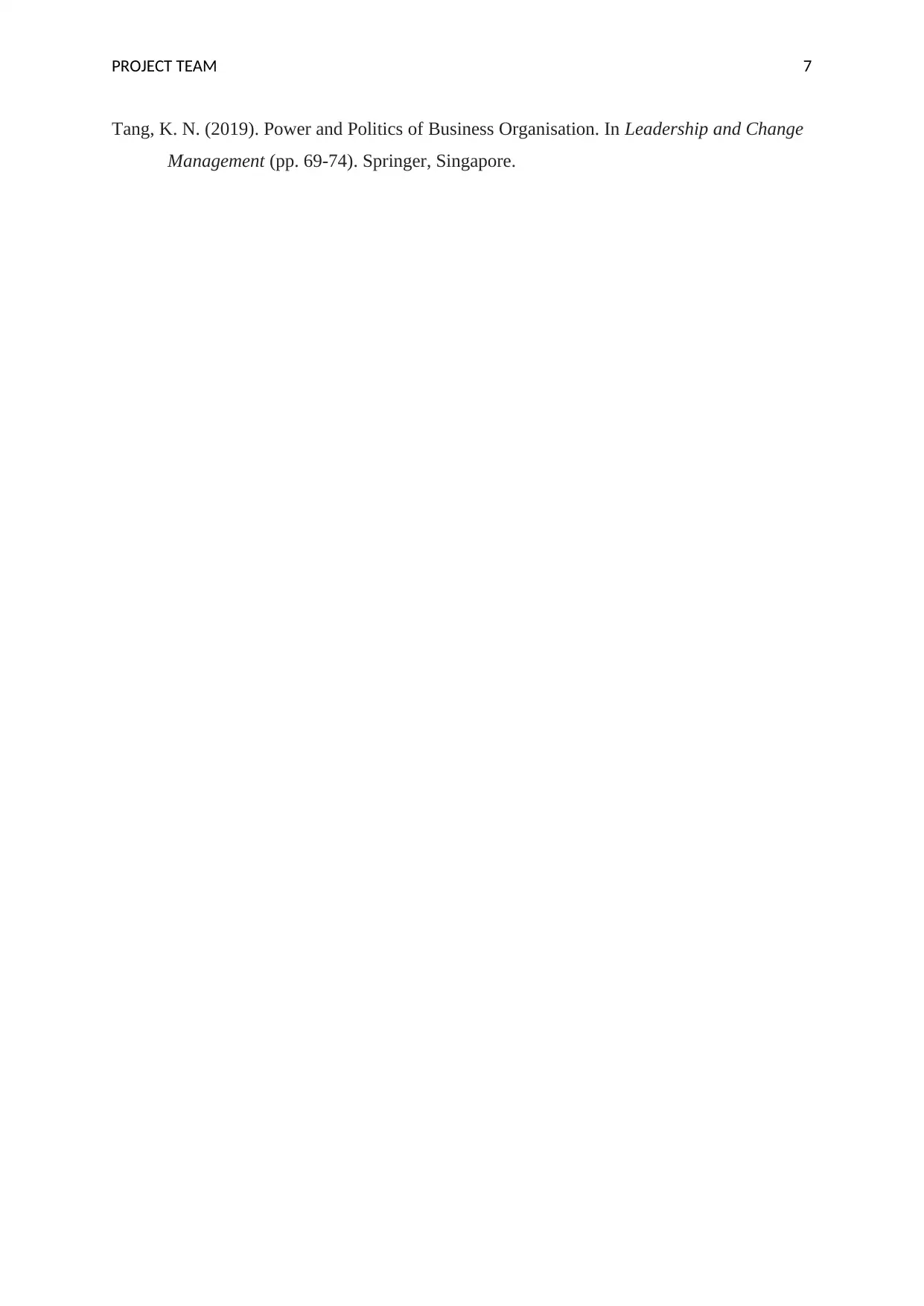
PROJECT TEAM 7
Tang, K. N. (2019). Power and Politics of Business Organisation. In Leadership and Change
Management (pp. 69-74). Springer, Singapore.
Tang, K. N. (2019). Power and Politics of Business Organisation. In Leadership and Change
Management (pp. 69-74). Springer, Singapore.
1 out of 8
Related Documents
Your All-in-One AI-Powered Toolkit for Academic Success.
+13062052269
info@desklib.com
Available 24*7 on WhatsApp / Email
![[object Object]](/_next/static/media/star-bottom.7253800d.svg)
Unlock your academic potential
© 2024 | Zucol Services PVT LTD | All rights reserved.





